Timeline of private spaceflight
Appearance
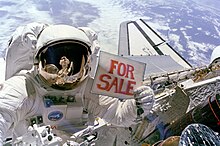
The following is a timeline of important events in the history of private spaceflight, including important technical as well as legislative and political advances. Though the industry has its origins in the early 1960s, soon after the beginning of the Space Age, private companies did not begin conducting launches into space until the 1980s, and it was not until the 21st century that multiple companies began privately developing and operating launch vehicles and spacecraft in earnest.
Before 1980
[edit]- 12 December 1961 – OSCAR 1, the first amateur built satellite, is launched aboard an American Thor-Agena rocket.[1]
- 10 July 1962 – Telstar 1, the first satellite to be used commercially, is launched on the first commercially sponsored space launch, aboard a Thor-Delta rocket.[2]
- 31 August 1962 – President John F. Kennedy signs the Communications Satellite Act of 1962 providing the regulatory framework for private companies in the United States to own and operate their own satellites.
- 6 April 1965 – Intelsat Intelsat 1 known as "Early Bird" was the first commercial communications satellite to be placed in geosynchronous orbit.
- 9 November 1972 – Canadian Telesat Anik A1 launched world's first domestic communications satellite in geostationary orbit operated by a commercial company.
- 13 April 1974 – Western Union Westar 1 becomes America's first domestic and commercially launched geostationary communications satellite.
- 1975 – OTRAG, the first company to attempt private development and manufacture of space propulsion systems, is founded in Stuttgart, Germany, though its program is ultimately abandoned in the early 1980s.[3]
1980s
[edit]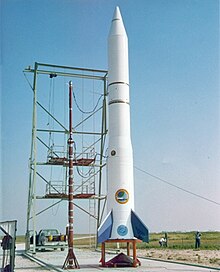
- 9 September 1982 – Conestoga I, a repurposed Minuteman second stage, is launched from Matagorda Island to an altitude of 309 km (192 miles) by Space Services Inc., becoming the first privately owned and operated rocket to reach space.[4][5]
- 10 September 1982 or 16 June 1983 – Europe's Arianespace becomes the world's first commercial launch service provider.[6][7]
- 30 October 1984 – President Ronald Reagan signs the Commercial Space Launch Act of 1984, which mandates NASA to encourage private spaceflight, and authorizes the Office of Commercial Space Transportation to regulate private spaceflight in the United States.[8][9]
- 15 June 1988 – PanAmSat PAS-1 becomes the first privately owned international telecommunications satellite.
- 29 March 1989 – Starfire, a repurposed Black Brant sounding rocket launched by Space Services Inc., is the first rocket to launch with a commercial launch license from the Office of Commercial Space Transportation.[10]
1990s
[edit]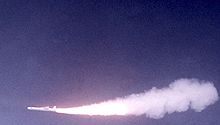
- 5 April 1990 – Pegasus, an air launched rocket developed by Orbital Sciences Corporation becomes the first launch vehicle fully developed by a private company to reach space, as well as the first air launched rocket of any kind to reach orbit[11]
- 16 November 1992 – Space Flight Europe-America 500, an orbital mission consisting of a space capsule bearing gifts from Russia to the United States, is launched by the Russian company TsSKB-Progress aboard a Soyuz rocket, before landing six days later off the coast of Grays Harbor in the United States.[12]
- November 1995 – The Office of Commercial Space Transportation is transferred to the Federal Aviation Administration (FAA), becoming the FAA Associate Administrator for Space Transportation, or FAA/AST.[10]
- May 1996 – Creation of the Ansari X-Prize.
- 24 December 1997 – DigitalGlobe EarlyBird-1 becomes the first commercial Earth imaging satellite.
- 13 May 1998 – HGS-1, a communications satellite operated at the time by Hughes Global Services Inc., becomes the first commercial spacecraft to visit the Moon, after flying to within 6,200 km of the lunar surface on a free return trajectory to salvage it from an unusable orbit.[13][14]
2000s
[edit]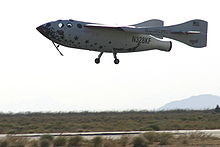

- 4 April 2000 – Soyuz TM-30, a crewed mission to the space station Mir arranged by the company MirCorp in collaboration with the Russian Federal Space Agency, launches, becoming the first privately funded space station expedition.[15]
- 28 April 2001 – Dennis Tito becomes the first space tourist, launching to the International Space Station on Expedition 2 aboard a Russian Soyuz spacecraft after paying for a seat arranged by the American company Space Adventures.[16]
- 17 May 2004 – The Civilian Space eXploration Team (CSXT) becomes the first amateur organization to send a rocket into space, with the launch of their "GoFast" rocket to 116 km (72 miles) altitude.[17]
- 21 June 2004 – Scaled Composites’ SpaceShipOne conducts the first privately flown and funded crewed spaceflight, piloted by Mike Melvill.[18]
- 4 October 2004 – Scaled Composites Tier One officially wins the Ansari X Prize with SpaceShipOne.
- 23 December 2004 – President George W. Bush signs the Commercial Space Launch Amendments Act of 2004, which provides a basic legal framework for commercial human spaceflight.[19] It also creates the so-called "learning period," a temporary restriction on the FAA's ability to regulate the private spaceflight industry, which has since been extended multiple times.[20]
- 12 July 2006 – A Russian-Ukrainian Dnepr rocket launches Genesis I, an experimental inflatable space habitat developed and owned by Bigelow Aerospace that is the first inflatable habitat module to reach orbit.[21]
- 28 September 2008 – SpaceX conducts the first successful launch of its Falcon 1 rocket, the first privately developed fully liquid fueled rocket to reach orbit.[22]
2010s
[edit]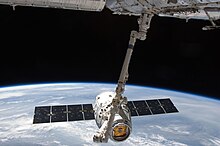
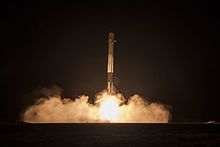
- 8 December 2010 – SpaceX successfully launches and recovers its Dragon capsule on its first mission, marking the first time a privately developed and operated spacecraft is recovered from orbit.[23]
- 25 May 2012 – The second mission of SpaceX's Dragon capsule completes a successful rendezvous and berthing with the International Space Station, making it the first private spacecraft to do so.[23]
- 3 December 2013 – SpaceX successfully launches SES-8 with its Falcon 9 rocket, marking the first time a privately developed rocket reached geostationary transfer orbit.
- May–July 2014 – A private initiative known as the ISEE-3 Reboot Project successfully contacts and takes control of NASA's defunct ISEE-3 space probe with support from NASA and the Arecibo Observatory, making them the first private group to command a spacecraft in deep space, though their plans to change the probe's orbit are abandoned weeks later when its thrusters fail to respond properly.[24][25]
- 23 October 2014 – LuxSpace, an aerospace contractor based in Luxembourg, launches the Manfred Memorial Moon Mission (4M), the first commercial payload sent to fly by the Moon, attached to the third stage of the rocket that lifted Chinese lunar flyby spacecraft Chang'e 5-T1.[26]
- 11 February 2015 – SpaceX launches NOAA's DSCOVR spacecraft to the L1 Lagrange point on a Falcon 9, marking the first time a privately developed rocket flew a payload beyond geostationary transfer orbit.
- 23 November 2015 – Blue Origin successfully launches its New Shepard launch system into space and lands it vertically, making it the first VTVL rocket to land on Earth from space.[27]
- 25 November 2015 – President Barack Obama signs the U.S. Commercial Space Launch Competitiveness Act, also known as the Spurring Private Aerospace Competitiveness and Entrepreneurship Act or SPACE Act of 2015, which codifies the ability of American companies to own material resources extracted in outer space.[20]
- 21 December 2015 – SpaceX lands the first stage of its Falcon 9 at Landing Zone 1 at Cape Canaveral, marking the first recovery of a VTVL stage from an orbital rocket.[28]
- 22 January 2016 – Blue Origin successfully launches and lands the same New Shepard booster flown in November, making it the first VTVL rocket to reach space twice.[29]
- 30 March 2017 – SpaceX launches SES-10, during which they successfully launch and land the first stage of a Falcon 9 that had previously flown as part of their CRS-8 mission in April 2016, making it the first VTVL rocket to be used on two orbital flights.[30]
- 13 July 2017 – The Luxembourg Chamber of Deputies adopts a law guaranteeing companies the right to own resources extracted in space, making Luxembourg the first European nation to do so.[31][32]
- 21 January 2018 – American aerospace company Rocket Lab successfully launched its Electron rocket from Mahia Launch Center on January 21, 2018 carrying three CubeSats into low Earth orbit. This was the first time that a rocket entered orbit after launching from a privately owned and operated spaceport.
- 6 February 2018 – SpaceX launches a demonstration mission on their inaugural Falcon Heavy flight, during which they marked the first privately developed rocket to reach heliocentric orbit.
2020s
[edit]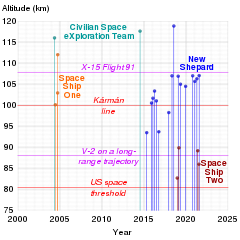
- 30 May 2020 – SpaceX successfully launches a Falcon 9 rocket carrying the Crew Dragon space capsule during the Demo-2 mission, marking the first privately-developed crewed mission to orbit, the first to visit the ISS, and the first American crewed mission in general since STS-135 in 2011.
- 11 July 2021 – Virgin Galactic successfully launches Richard Branson on a SpaceShipTwo to space, marking the first privately-developed crewed mission to space carrying a founder of a space company. It however did not reach the Karman Line.
- 20 July 2021 – Blue Origin successfully launches Jeff Bezos on a New Shepard rocket to space above the Karman Line, marking the first privately-developed crewed mission to space with a company founder to get above the Karman Line. The mission also launched the first person born in the 21st century in space and first teenager in space (Oliver Daemen).[33]
- 2 September 2021 – Firefly Aerospace launches its Alpha FLTA001 rocket DREAM Test Flight carrying demonstration payloads.[34]
- 16 September 2021 – SpaceX operates the Inspiration4 mission, the first orbital spaceflight with only private citizens aboard.[35]
- 8 April 2022 – Axiom Mission 1 by Axiom Space is the first wholly commercially-operated crewed mission to the International Space Station.
- 1 October 2022 – Firefly Aerospace launches its Alpha FLTA002 rocket for the TO THE BLACK mission. The mission was the first successful orbital launch for the company.[36]
- 20 April 2023 – SpaceX launches Starship, the largest and most powerful rocket to date, with twice the thrust of the Saturn V. It however fails 4 minutes into flight.[37]
- 21 May 2023 – Axiom Mission 2 marks the first time a commercially operated crewed mission was used to fly government astronauts as well as being the first private mission with a female commander.
- 14 September 2023 – Firefly Aerospace conducts a successful orbital launch with the VICTUS NOX mission for the U.S. Space Force Space Systems Command. Firefly launched this mission 27 hours after receiving notice to launch, setting a new national security mission responsive-launch record.[38]
- 22 December 2023 – Firefly Aerospace launches the Fly the Lightning mission, carrying a Lockheed Martin payload, on its Alpha FLTA004 rocket.[39]
- 22 February 2024- IM-1 Odysseus marks the first successful private lunar landing and the first to do so with cryogenic propellants.[40]
- 5 June 2024– ULA successfully launches an Atlas V rocket carrying the Boeing Starliner space capsule during the CFT mission, marking the Starliner operational to conduct crewed mission to orbit and visit the ISS.
- 21 June 2024 - Rocket Lab's Electron becomes the fastest privately developed orbital launch vehicle to 50 launches in history.[41]
- 3 July 2024 – Firefly Aerospace launches the Noise of Summer mission for NASA's Venture Class Launch Services.[42]
- 10 September 2024 – Polaris Dawn gets launched and performs the first commercial extravehicular activity, as well as breaks the non-Apollo record of highest orbit flown set by Gemini 11 in 1966. It is being funded by the Polaris Program, founded by Jared Isaacman.
- 16 January 2025 - Blue Origin launches their maiden flight of their New Glenn rocket, the company's orbital launcher.
Future
[edit]- 30 December 2024 – Planned launch of Rocket Lab's Venus Life Finder, an atmospheric probe anticipated to be the first private mission to another planet.
- Mid 2020s – Polaris III is a planned mission that will involve the first ever crewed launch of SpaceX's Starship vehicle with a crew onboard, it is being funded by the Polaris Program, founded by Jared Isaacman.[43]
See also
[edit]- Billionaire space race
- Commercialization of space
- History of spaceflight
- List of fully civilian crewed orbital spaceflights
- List of fully civilian crewed suborbital spaceflights
- Timeline of space exploration
References
[edit]- ^ "OSCAR I and Amateur Radio Satellites: Celebrating 50 Years". ARRL. May 11, 2011. Archived from the original on April 16, 2016. Retrieved June 17, 2016.
- ^ "July 12, 1962: The Day Information Went Global". NASA. July 9, 2012. Archived from the original on July 10, 2021. Retrieved June 17, 2016.
- ^ "Otrag". astronautix. Archived from the original on July 16, 2016. Retrieved 12 February 2020.
- ^ Abell, John (September 9, 2009). "Sept. 9, 1982: 3-2-1 ... Liftoff! The First Private Rocket Launch". Wired. Archived from the original on October 9, 2016. Retrieved September 29, 2017.
- ^ "Heritage: Pioneering the Commercial Space Frontier". Space Services Inc. Archived from the original on 3 August 2015. Retrieved 17 June 2016.
- ^ Jaeger, Ralph-W.; Claudon, Jean-Louis (May 1986). Ariane — The first commercial space transportation system. Proceedings of the 15th International Symposium on Space Technology and Science. Vol. 2. Tokyo, Japan: AGNE Publishing, Inc. (published 1986). Bibcode:1986spte.conf.1431J. A87-32276 13–12.
- ^ "Arianespace was founded in 1980 as the world's first launch services company". arianespace.com. Archived from the original on 18 February 2008. Retrieved 7 March 2008.
- ^ "Fact Sheet – Commercial Space Transportation". FAA/AST. Archived from the original on 13 October 2016. Retrieved 17 June 2016.
- ^ "H.R.3942 – Commercial Space Launch Act". Congress.gov. 30 October 1984. Archived from the original on 10 August 2016. Retrieved 17 June 2016.
- ^ a b "About the Office". FAA/AST. Archived from the original on 14 July 2016. Retrieved 17 June 2016.
- ^ "Pegasus". Orbital ATK. Archived from the original on 23 June 2016. Retrieved 17 June 2016.
- ^ "Russian Satellite to Splash Down Near Washington's Grays Harbor". Journal of Commerce. November 17, 1992. Archived from the original on June 30, 2016. Retrieved June 17, 2016.
- ^ "Hughes Salvages HGS-1 With Geo Orbit Transfer Via Moon". Space Daily. June 8, 1998. Archived from the original on September 29, 2017. Retrieved September 29, 2017.
- ^ "Satellite Drama's Happy End". Wired. June 19, 1998. Archived from the original on September 29, 2017. Retrieved September 29, 2017.
- ^ "Soyuz TM-30 Return-to-Earth Timeline". Space Ref. June 15, 2000.[permanent dead link]
- ^ Wall, Mike (April 27, 2011). "First Space Tourist: How a U.S. Millionaire Bought a Ticket to Orbit". Space.com. Archived from the original on June 17, 2016. Retrieved June 17, 2016.
- ^ "Go "GoFast"! Space Frontier Foundation Congratulates First Amateur Team to Enter Space". Space Frontier Foundation. May 19, 2004. Archived from the original on March 7, 2019. Retrieved June 17, 2016.
- ^ Coren, Michael (July 14, 2004). "Private craft soars into space, history". CNN. Archived from the original on August 12, 2016. Retrieved June 17, 2016.
- ^ Boyle, Alan (December 23, 2004). "Private-spaceflight bill signed into law". NBC. Archived from the original on December 31, 2014. Retrieved June 17, 2016.
- ^ a b Grush, Loren (November 16, 2015). "Private space companies avoid FAA oversight again, with Congress' blessing". The Verge. Archived from the original on June 1, 2017. Retrieved September 16, 2017.
- ^ Harding, Pete (May 28, 2016). "ISS controllers complete BEAM module expansion". NASA Spaceflight. Archived from the original on June 18, 2016. Retrieved June 17, 2016.
- ^ Clark, Stephen (September 28, 2008). "Sweet success at last for Falcon 1 rocket". Spaceflight Now. Archived from the original on October 3, 2015. Retrieved June 17, 2016.
- ^ a b "SpaceX becomes first private firm to launch craft to space station". The Telegraph. May 22, 2012. Archived from the original on August 26, 2016. Retrieved April 4, 2018.
- ^ Chang, Kenneth (June 14, 2014). "Calling Back a Zombie Ship From the Graveyard of Space". The New York Times. Archived from the original on January 4, 2018. Retrieved March 3, 2017.
- ^ Davis, Jason (August 8, 2014). "Data From the Rescued ISEE-3 Spacecraft Have a New Internet Home". The Planetary Society. Archived from the original on May 1, 2016. Retrieved June 17, 2016.
- ^ Clark, Stephen (October 25, 2014). "First commercial mission to the moon launched from China". Spaceflight Now. Archived from the original on May 21, 2016. Retrieved June 17, 2016.
- ^ Foust, Jeff (November 24, 2015). "Blue Origin Flies — and Lands — New Shepard Suborbital Spacecraft". Space News. Archived from the original on March 27, 2023. Retrieved June 17, 2016.
- ^ Zhang, Sarah (December 12, 2015). "SpaceX's Falcon Rocket Finally Sticks the Landing". Wired. Archived from the original on March 22, 2017. Retrieved March 12, 2017.
- ^ Rhian, Jason (January 22, 2016). "Blue Origin re-flies New Shepard used on Nov. 2015 flight". Spaceflight Insider. Archived from the original on June 20, 2017. Retrieved September 29, 2017.
- ^ Graham, William (March 30, 2017). "SpaceX conducts historic Falcon 9 re-flight with SES-10 – Lands booster again". NASA Spaceflight. Archived from the original on May 17, 2017. Retrieved September 29, 2017.
- ^ "Lux. Passes Space Mining Law". Delano. July 13, 2017. Archived from the original on September 9, 2019. Retrieved September 29, 2017.
- ^ Jamasmie, Cecilia (July 13, 2017). "Luxembourg becomes first European country to pass space mining law". Mining.com. Archived from the original on September 22, 2017. Retrieved September 29, 2017.
- ^ "Jeff Bezos launches to space aboard New Shepard rocket ship". BBC News. 2021-07-19. Archived from the original on 2023-02-04. Retrieved 2023-02-06.
- ^ Clark, Stephen (2 September 2021) Firefly set for inaugural test launch from Vandenberg... SpaceflightNow Retrieved September 9, 2024.
- ^ Davenport, Christian (15 September 2021). "SpaceX makes history by launching Inspiration4, first all-civilian crew, to orbit". The Washington Post. Archived from the original on 16 September 2021. Retrieved 16 September 2021.
The Inspiration4 mission may be the first time a spaceflight crew is comprised entirely of civilians – nongovernment astronauts. There has been a long history of ordinary citizens going to space. In fact, that was NASA's goal at the beginning of the space shuttle era – to fly regular people on a routine basis
- ^ Sesnic, Trevor (1 October 2022) Firefly succeeds on second Alpha flight... NASASpaceflight Retrieved September 9, 2024
- ^ "SpaceX's gigantic Starship rocket blasts off and then explodes in its first test flight". NBC News. 20 April 2023. Archived from the original on 2023-05-14. Retrieved 2023-05-15.
- ^ Erwin, Sandra (26 September 2023) After setting new record for responsive launch, Space Force eyes next challenge...SpaceNews Retrieved September 9, 2024.
- ^ Quijas, Ryan (22 December 2023) Firefly's Fly the Lightning Mission Launches from Vandenberg... U.S. Space Force Retrieved September 9, 2024.
- ^ Michael Sheetz (2024-02-22). "Intuitive Machines lands on the moon in historic first for a U.S. company". CNBC.com. Archived from the original on 2024-02-22. Retrieved 2024-02-22.
- ^ "Rocket Lab successfully launches its 50th Electron rocket – Spaceflight Now". Retrieved 2024-06-22.
- ^ ... McCrea, Aaron (1 July 2024) Firefly successfully launched Alpha on Noise of Summer NASASpaceflight Retrieved September 9, 2024
- ^ Kurkowski, Seth (April 14, 2024). "Polaris Dawn is getting closer and closer to being launch ready". Space Explored. Retrieved April 25, 2024.
